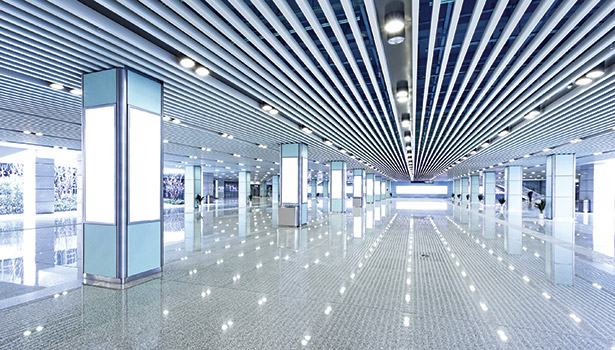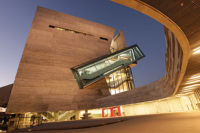The facts are simple: Lighting makes up approximately 40 percent of the average commercial building’s electric bill, according to the U.S. Department of Energy, and that number is climbing. Energy consumption by commercial buildings rose 69 percent from 1980 to 2009, while the Energy Information Administration projects consumption is estimated to grow another 22 percent from 2009 to 2035, according to business research analysts from IBISWorld.
“At a time when 20 percent of the world’s electricity is used for lighting — and commercial lighting systems count for over 50 percent of the total electricity used for lighting — retrofits and upgrades that allow lighting systems to use energy more efficiently may be one of the best places to create improvements,” says Daintree Networks Inc., Los Altos, Calif.
Some studies estimate that up to 60 percent energy savings in commercial and industrial facilities can be achieved with commercial lighting controls. The cost savings and return on investment is a powerful argument — let alone the additional benefit of reducing a company’s carbon footprint and increasing its environmental responsibility. Commercial lighting controls offer powerful benefits for end users, and also are a strong “first step” for systems integrators to offer full building automation systems (BAS).
“Lighting is an entry point into BAS because it is often easier to install lighting controls or overhaul the light bulbs in a building than it is to do a full retrofit or system install,” observes Rawlson O’Neil King, communications director, Continental Automated Buildings Association (CABA), Ottawa, Ontario, Canada.
Frank Yoder, a veteran with 20 years of experience in BAS at Avantech Inc., located in Dover, Del., also considers lighting control as an initial step into building automation, especially when it is linked with a security system. “A card swipe or the arm/disarm of an intrusion panel could change a building or targeted offices from unoccupied to occupied. Lighting has been one of the first areas energy engineers and performance contractors will approach when reducing facility’s energy consumption,” Yoder reports.
Lighting control tantalizes commercial customers with huge potential cost savings that are hard to ignore.
A real estate income trust’s chief financial officer (CFO) decided to employ lighting controls in the trust’s buildings, King recalls. There was a definite benefit — both environmental and cost savings — plus, it promised a good return on investment. “It made the CFO look like a hero, reducing costs by $4 million to $6 million a year. That was money that was already going to be spent, but because the lighting control saved the money, it went directly back to the investors, making them happy and sending a positive message about the environment. Win, win,” King describes.
Lighting control systems do not have to be elaborate to have a positive impact, enabling integrators to start at the level with which they are comfortable. Simply suggesting the move from old bulbs to LEDs can cut a lot from lighting costs, and that exponentially grows as more energy efficacy is enabled with lighting controls, King says.
“We are seeing a major focus on lighting controls because it dramatically improves energy efficiency and even employee productivity, another major driver for system upgrades and installations. When you have a more efficient and healthy building, you will also have more productivity take place by employees in that building,” King explains.
Global control from a management standpoint and automation (turning lights on and off based upon time-of-day settings and astronomical clock) are major drivers selling commercial lighting for Universal Protection Security Systems, Santa Ana, Calif., shares Denny Stover, executive vice president, San Diego and Northern California. He adds that integrators succeed with commercial lighting control by focusing on energy and cost savings long-term and the general ease of use it provides.
As an added security feature, his company programs the lights to flash when the alarm is triggered to allow police and emergency personnel to locate the property in distress.
Diebold is seeing increased interest from building managers looking to become smarter about energy use related to HVAC, lighting and transportation systems. “They want systems that can proactively shut off lights and shift temperature settings when the last person leaves,” says Jeremy Brecher, vice president, technology for Diebold Security, adding that the ultimate goal is to best match building energy usage with the real-time needs of the occupants, driving energy savings from proper management.
Because commercial lighting control comes with such clear benefits for businesses, it can serve as a highly proven, quality “first step” for integrators delving into building automation services.
Are you diving into commercial lighting control or finding success offering it? Tell SDM about it. Contact Heather Klotz-Young, SDM senior editor, at klotz-youngh@bnpmedia.com.
Components of Lighting Control Systems
Lighting control systems deliver the correct amount of light, where you want it, when you want it. Lights can automatically turn on, off or dim at set times or under set conditions; facilities managers can make changes to lighting when appropriate or to meet financial incentives; and users can have control over their own lighting levels to provide optimal working conditions. Lighting control helps to reduce costs and conserve energy by turning off (or dimming) lights when they are not required.
Lighting control systems include some or all of the following:
- on/off and dimming controls;
- occupancy sensors to detect whether rooms are occupied;
- photo sensors to detect the current illumination levels provided by natural and/or artificial light;
- scheduling that turns on, off, and dims luminaires at preset times;
- a centralized control system interface (such as a wall panel or computer software) to manage all of the above;
- a method of communication between the lighting equipment and control system; and
- a method of measuring, displaying, and responding to lighting energy usage.
— Contributed by Daintree Networks
Types of Lighting Controls
The simplest lighting control system turns off (or dim) lights at a specified time when a building is assumed to be empty, and turns lights on again before people arrive for work the next day. “This is a start, but with today’s offices where people are increasingly working longer, more flexible hours, additional controls are needed,” according to Daintree Networks. The best controls maximize the flexibility of a lighting system while eliminating light usage, often automatically. Common controls include:
Occupancy sensors
Occupancy sensors use sound or motion control to automatically dim or switch lights on and off. If an area has not been occupied for a specified amount of time, lights can be switched off; then, when motion is detected, lights can be switched back on. Some estimates say this can result in up to 45 percent energy savings.
Dimmers
Dimmers, available for fluorescent and incandescent systems, can allow the user to adjust the level of lighting from very bright to near dark. Some estimates say this will save up to 9 percent in electricity usage over a standard toggle switch.
Daylight dimming
Special daylight dimmers will automatically dim room lights based on the amount of free and natural daylight available. This is an alternative option to shutting off the lights.
Time scheduling
Timers can be used to set lighting levels for different times of day, but they do not react as effectively to shifting daylight conditions as daylight sensors.
Bi-level switching
Bi-level switching allows one to turn off half of the lights in a room (think front of the room or back of the room) if full illumination is not required.
How to Help Customers With Funding
There are various rebates and incentives that promote energy-efficient lighting systems. Leviton Mfg. Company Inc., Mellville, N.Y., offers a unique Incentive Search on its website to search for lighting-related rebates and incentives that integrators can present to potential customers. According to the company, incentives to purchase and install energy-efficient products can come from:
- Local and state utilities,
- state energy efficiency programs,
- EPAct tax incentives, and
- federal stimulus monies that focus on energy efficiency.
“Energy-efficiency projects [such as lighting] reduce or eliminate expenses that would otherwise be incurred, typically by using proven technologies and time-tested methods. This makes them relatively low-risk investments that are easier to finance than other projects that carry greater risk. In addition to traditional sources of funding — financial institutions and capital markets — many utilities, governments and non-profit organizations offer financial support through grants, rebates and loans. Well-designed efficiency projects are almost always fundable,” Energy Star emphasizes in the “Energy Star Building Manual.”
Energy Savings Potential
Lighting has been estimated to have the largest potential for energy savings of any U.S. building energy use. A significant percentage of that potential is believed to come from lighting system controls. Researchers have been quantifying energy savings from lighting controls in commercial buildings for more than 30 years, but results vary widely. A meta-analysis of energy savings potential reported in “Quantifying National Energy Savings Potential of Lighting Controls in Commercial Buildings” by Alison Williams, Barbara Atkinson, Karina Garbesi, Francis Rubinstein, Lawrence Berkeley National Laboratory, and Erik Page, Erik Page & Associates Inc., used 240 savings estimates from 88 published sources to generate estimates of average savings. These were:
- 24% for occupancy
- 28% for daylighting
- 31% for personal tuning
- 36% for institutional tuning
- 38% for combined approaches
The meta-analysis showed that individual control strategies saved on average between one-quarter and one-third of lighting energy and multiple control strategies could capture up to nearly 40 percent savings on average. These figures indicated that a full implementation of lighting controls (while accounting for existing lighting controls penetration) could save up to 19 percent of annual national lighting energy, or 67 TWh/year.
Produce Lighting Proposals on Site
Energy Squad, Bethesda, Md., a green technology distributor, offers the Energy Squad ecoInsight Lighting Proposal Tool, a mobile resource that allows dealers to easily specify, source and create proposals for LED lighting projects. This software program reduces the time it takes dealers to create energy-efficiency proposals nearly in half, according to the company.
The Energy Squad ecoInsight Lighting Proposal Tool — created in conjunction with ecoInsight Inc. — is an iPad app that organizes specific information relative to each specific proposal. With the ability to enter all aspects of the energy-saving equation in one program, dealers can efficiently collect project data in real time.
Once information about the lighting needs for a project have been collected, a dealer can instantly access Energy Squad’s entire catalog of LED lighting brands and products to specify the appropriate solutions for the setting. Within a very short time, the dealer can create an in-depth proposal for the client, illustrating the project cost and payback period, as well as a comprehensive analysis of long-term cost savings based on the client’s conversion to the specified LED lighting products, according to Energy Squad. For information, visit www.energysquad.com/become-dealer-partner.



